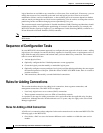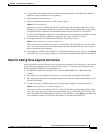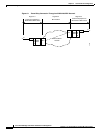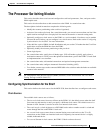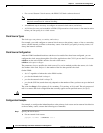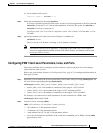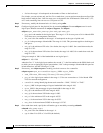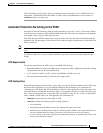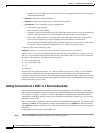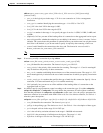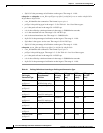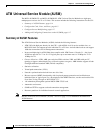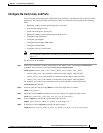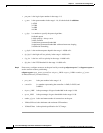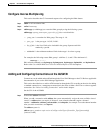
6-10
Cisco MGX 8230 Edge Concentrator Installation and Configuration
Release 1.1.31, Part Number 78-11215-03 Rev. B0, May 2001
Chapter 6 Card and Service Configuration
The Processor Switching Module
–
enable use of K1 and K2 bytes in the line-level frame for equipment at both ends to exchange
APS-related information
• delapsln to delete the APS configuration
• dspapsln to display the configuration for an APS-configured line
• switchapsln to issue commands for line switching that:
–
clear previous user requests
–
lock out (block) line switching
–
manually switch to the protection line if the following are true: no errors exist, the working line
is active, and your request has an equal or higher priority than the last switch request.
–
force a line switch regardless of existing errors if the following are true: the working line is
active and your request has an equal or higher priority than the last switch request.
–
switch all traffic to either the working lines or protection lines so you can remove a card (applies
to only the currently supported configuration of 1+1 mode on two uplink cards).
To specify APS, use the following syntax:
addapsln <workline> <workingslot> <protectionline> <protectionslot> <archmode>
where workline and workingslot identify the line and slot of the APS working line, and protectionline
and protectionslot identify the protection line and slot. According to GR-253, the archmode identifies
the type of APS operation. The mode definition includes:
1. 1+1 on one back card
2. 1+1 on two back cards
3. 1:1
4. Annex B
Currently, the only supported mode is 1+1 with two uplink cards (mode=2). With 1+1 APS, both the
working line and the protection line carry duplicate data even though no error threshold has been
exceeded or line break has occurred. This mode requires that two standard cables (rather than a Y-cable)
connect at two ports on the equipment at the opposite end. With the two-card implementation, workline
must be the same as protectionline.
Adding Connections on a PXM1 in a Stand-Alone Node
This section describes the CLI commands for provisioning connections on a PXM1 in a stand-alone
node. Connection addition conforms to the rules for a standard connection or a management connection.
(See “Rules for Adding Connections” earlier in this chapter). In addition, this section describes the
commands for modifying specific features for a connection and policing connections by way of usage
parameter control (UPC).
The CLI commands correspond to functions in the Cisco WAN Manager application. The preferred CLI
command is addcon. (If the application requires NSAP addressing, use addchan to add a connection
and cnfchan to modify a connection. To see the syntax for these two commands, refer to the command
reference.)
Complete the following steps on the PXM1 CLI:
Step 1 Execute the addcon command according to the following syntax:



